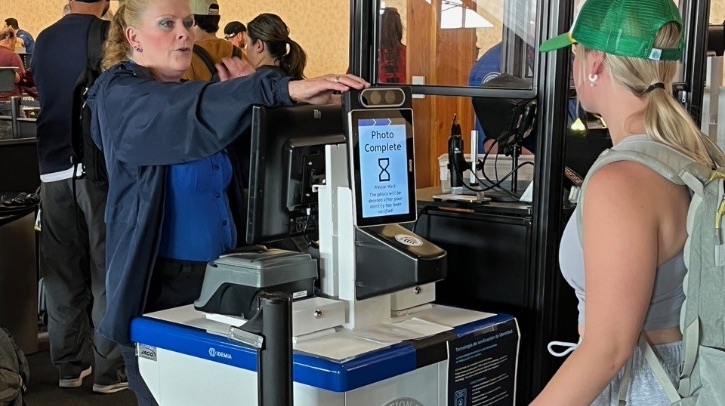Passengers departing from one of Montana’s five airports now have the option of having their identity verified by the latest generation of credential authentication technology (CAT).
The Transportation Security Administration (TSA) has deployed the units that use facial matching technology to verify the identity of travelers during the security screening process at Bozeman-Yellowstone International Airport, Billings International Airport, Great Falls International Airport, Helena Regional Airport and Missoula International Airport.
TSA has been using first-generation CAT units in Montana for a few years. They are designed to scan a traveler’s photo identification, confirm the individual is ticketed for travel and note the type of screening that the traveler is eligible for. The TSA officer visually verified the identity of the traveler using their photo identification. The new CAT-2 units have the same capabilities as the first-generation CAT units, but they are equipped with a camera that captures a real-time photo of the traveler.
In addition, TSA has also announced that it is installing CAT-2 at the main security checkpoint at Burlington International Airport in Vermont.
CAT-2 units compare the traveler’s photo on the ID against the in-person, real-time photo using facial matching technology. Once the CAT-2 unit confirms a match, the TSA officer will verify and the traveler can proceed to security screening. Photos are not stored and TSA officers can perform additional passenger verification if needed.
CAT-2 units have what is referred to as a ‘library of IDs programmed into them that enable the technology to authenticate more than 2,500 different types of IDs including passports, military common access cards, Department of Homeland Security Trusted Traveler ID cards, uniformed services ID cards, permanent resident cards, US visas and driver’s licenses and photo IDs issued by state motor vehicle departments.
In April, TSA administrator David Pekoske said TSA needs a total of 3,585 CAT units to reach full operational capability (FOC). “Currently, TSA estimates CPSS procurements are an estimated 40% of FOC, which puts deployments at approximately 35% for CPSS and 57% for CAT,” Pekoske said earlier this year. He added that TSA expects to meet FOC for CAT in fiscal year 2049, although the timeline could improve with budgetary support.
TSA is also rolling out checkpoint computed tomography (CT) units at pace. These systems are currently at just over 40% FOC with an expectation of completing procurement in 2042. Again, this forecast could improve with support as Pekoske said TSA “has the vendors, contracts and processes in place to significantly reduce the time to achieve FOC”. TSA’s FY 2025 President’s Budget request includes approximately US$90m to procure these new systems.
The CT units detect, among other things, firearms in carry-on baggage. In the USA, passengers can travel with their firearm but it must be securely packed in their hold baggage and not brought to the checkpoint or into the cabin. Even if the passenger has no nefarious intentions, another, perhaps unruly passenger could get hold of a firearm and they could also cause harm to TSA officers conducting bag searches, especially when loaded.
TSA recently announced that it intercepted 5,028 firearms at airport security checkpoints during the first nine months of 2024. This total represents an average of 18.3 firearms detected per day at TSA checkpoints, more than 93% of which were loaded.
With passenger volumes increasing by nearly 6.3%, the rate of firearms discoveries at TSA checkpoints during the most recent quarter (July – September) was 7.5 firearms per one million passengers, which is a decrease from the same period in 2023 when officers discovered 8.1 firearms per one million passengers.
Read more about TSA’s FY 2025 budget request for more CAT and CT systems here.


